Healthcare Management System Integration Report - Kory Family Hospital
VerifiedAdded on 2023/06/04
|5
|1086
|235
Report
AI Summary
This report focuses on the integration of a Healthcare Management System (HMS) at Kory Family Hospital, a nursing hospital in Bungoma County, Kenya. The report explores various aspects of HMS integration, including integration strategies based on the facility's goals and patient support needs. It discusses payment solutions, such as mobile payment and pay-bill options. The report also examines the benefits of electronic data interchange (EDI) in maintaining effective operations and improving data accuracy. Furthermore, it addresses change management strategies, training methods, and employee education to ensure successful integration. The report also analyzes the return on investment (ROI) of implementing the new system, considering factors like leadership, patient data, and the IT department's role in determining ROI success. The report concludes by emphasizing the importance of training and a well-structured approach to realize the objectives of the integrated system and improve the hospital's overall performance.
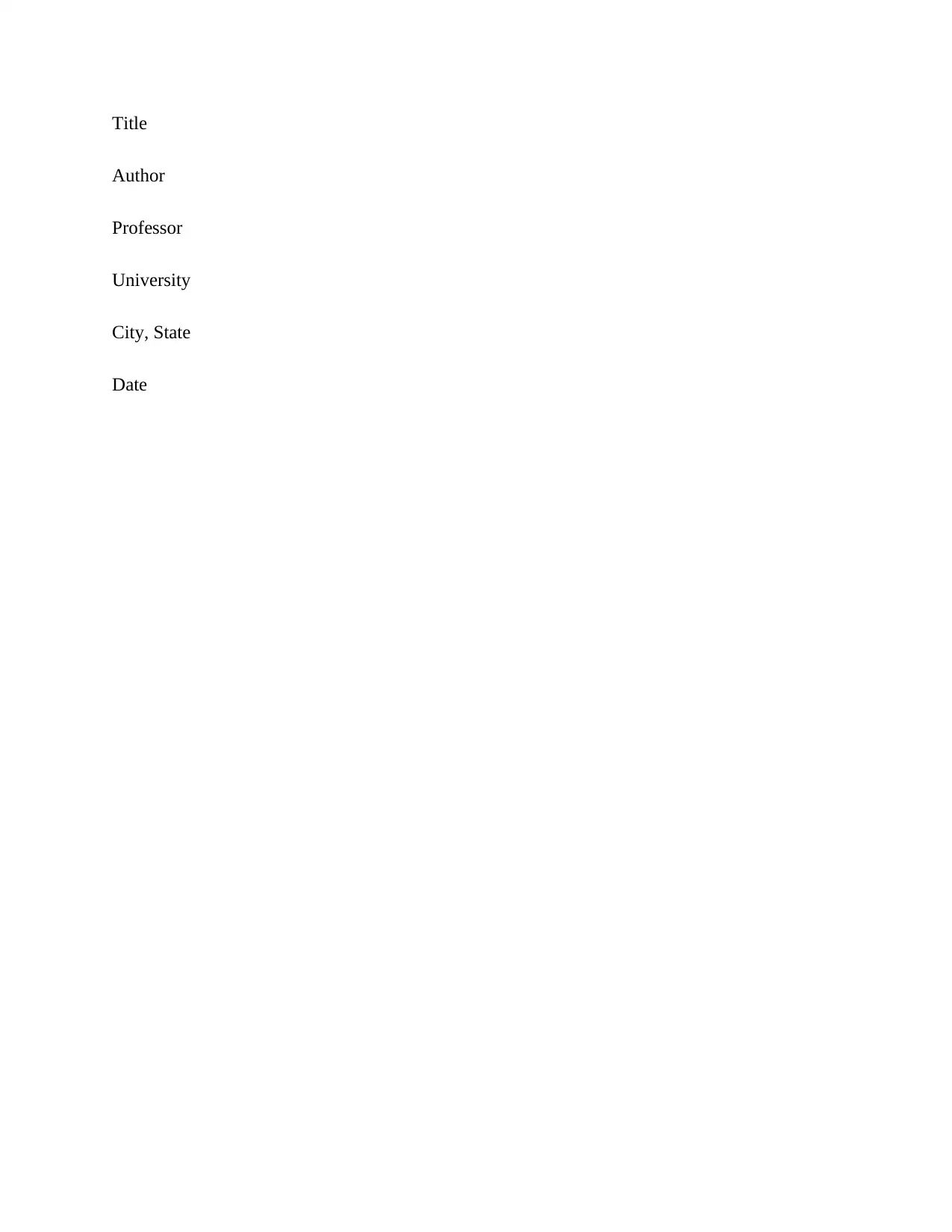
Title
Author
Professor
University
City, State
Date
Author
Professor
University
City, State
Date
Paraphrase This Document
Need a fresh take? Get an instant paraphrase of this document with our AI Paraphraser
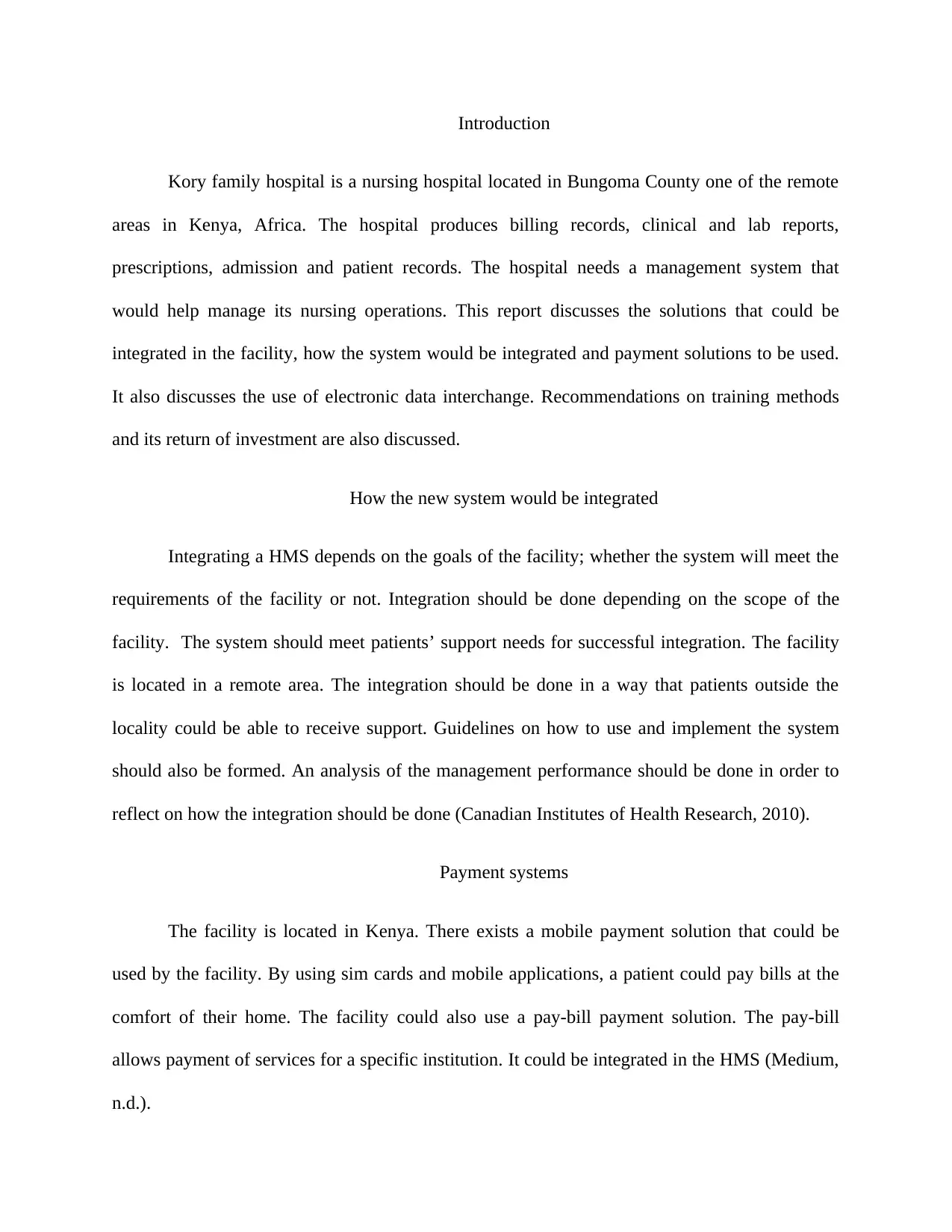
Introduction
Kory family hospital is a nursing hospital located in Bungoma County one of the remote
areas in Kenya, Africa. The hospital produces billing records, clinical and lab reports,
prescriptions, admission and patient records. The hospital needs a management system that
would help manage its nursing operations. This report discusses the solutions that could be
integrated in the facility, how the system would be integrated and payment solutions to be used.
It also discusses the use of electronic data interchange. Recommendations on training methods
and its return of investment are also discussed.
How the new system would be integrated
Integrating a HMS depends on the goals of the facility; whether the system will meet the
requirements of the facility or not. Integration should be done depending on the scope of the
facility. The system should meet patients’ support needs for successful integration. The facility
is located in a remote area. The integration should be done in a way that patients outside the
locality could be able to receive support. Guidelines on how to use and implement the system
should also be formed. An analysis of the management performance should be done in order to
reflect on how the integration should be done (Canadian Institutes of Health Research, 2010).
Payment systems
The facility is located in Kenya. There exists a mobile payment solution that could be
used by the facility. By using sim cards and mobile applications, a patient could pay bills at the
comfort of their home. The facility could also use a pay-bill payment solution. The pay-bill
allows payment of services for a specific institution. It could be integrated in the HMS (Medium,
n.d.).
Kory family hospital is a nursing hospital located in Bungoma County one of the remote
areas in Kenya, Africa. The hospital produces billing records, clinical and lab reports,
prescriptions, admission and patient records. The hospital needs a management system that
would help manage its nursing operations. This report discusses the solutions that could be
integrated in the facility, how the system would be integrated and payment solutions to be used.
It also discusses the use of electronic data interchange. Recommendations on training methods
and its return of investment are also discussed.
How the new system would be integrated
Integrating a HMS depends on the goals of the facility; whether the system will meet the
requirements of the facility or not. Integration should be done depending on the scope of the
facility. The system should meet patients’ support needs for successful integration. The facility
is located in a remote area. The integration should be done in a way that patients outside the
locality could be able to receive support. Guidelines on how to use and implement the system
should also be formed. An analysis of the management performance should be done in order to
reflect on how the integration should be done (Canadian Institutes of Health Research, 2010).
Payment systems
The facility is located in Kenya. There exists a mobile payment solution that could be
used by the facility. By using sim cards and mobile applications, a patient could pay bills at the
comfort of their home. The facility could also use a pay-bill payment solution. The pay-bill
allows payment of services for a specific institution. It could be integrated in the HMS (Medium,
n.d.).
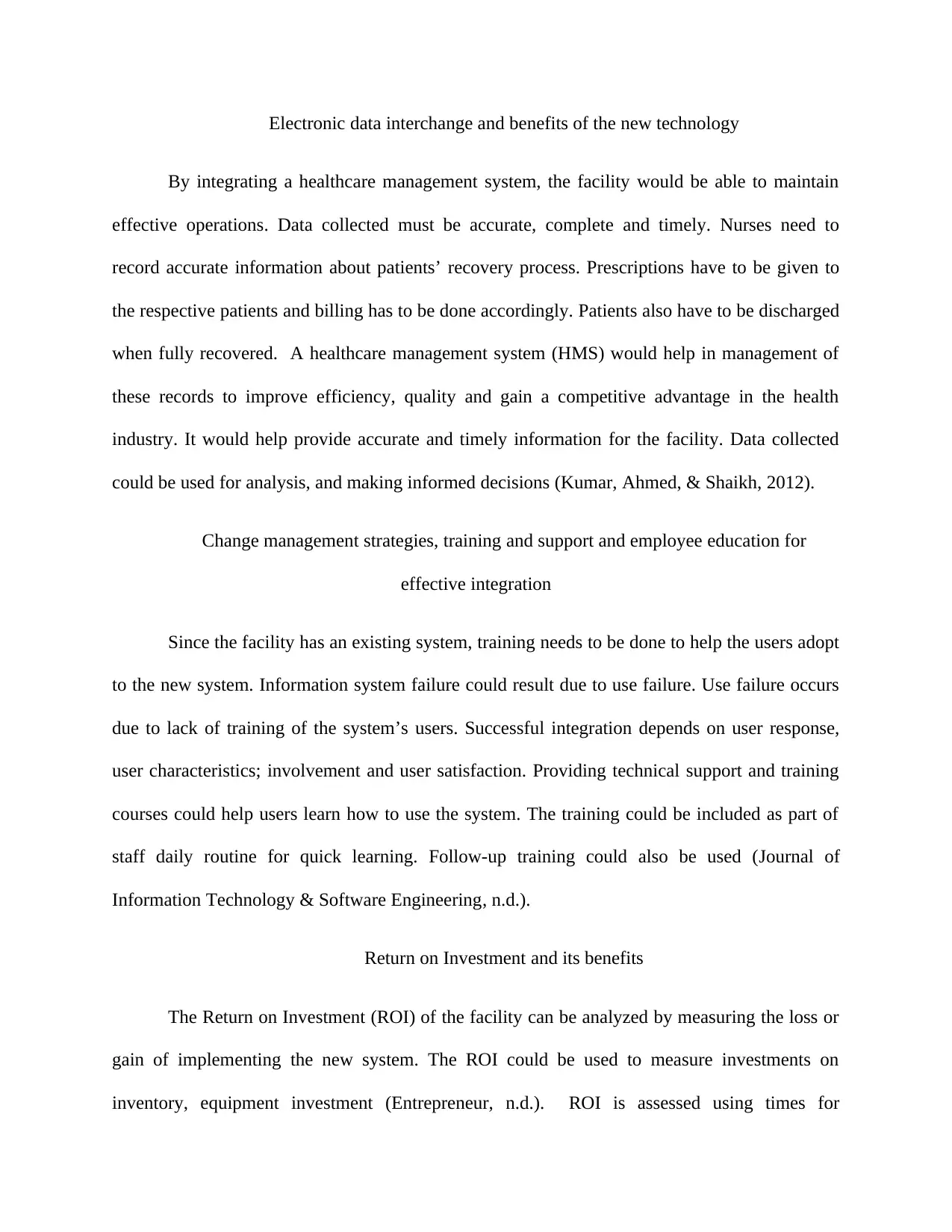
Electronic data interchange and benefits of the new technology
By integrating a healthcare management system, the facility would be able to maintain
effective operations. Data collected must be accurate, complete and timely. Nurses need to
record accurate information about patients’ recovery process. Prescriptions have to be given to
the respective patients and billing has to be done accordingly. Patients also have to be discharged
when fully recovered. A healthcare management system (HMS) would help in management of
these records to improve efficiency, quality and gain a competitive advantage in the health
industry. It would help provide accurate and timely information for the facility. Data collected
could be used for analysis, and making informed decisions (Kumar, Ahmed, & Shaikh, 2012).
Change management strategies, training and support and employee education for
effective integration
Since the facility has an existing system, training needs to be done to help the users adopt
to the new system. Information system failure could result due to use failure. Use failure occurs
due to lack of training of the system’s users. Successful integration depends on user response,
user characteristics; involvement and user satisfaction. Providing technical support and training
courses could help users learn how to use the system. The training could be included as part of
staff daily routine for quick learning. Follow-up training could also be used (Journal of
Information Technology & Software Engineering, n.d.).
Return on Investment and its benefits
The Return on Investment (ROI) of the facility can be analyzed by measuring the loss or
gain of implementing the new system. The ROI could be used to measure investments on
inventory, equipment investment (Entrepreneur, n.d.). ROI is assessed using times for
By integrating a healthcare management system, the facility would be able to maintain
effective operations. Data collected must be accurate, complete and timely. Nurses need to
record accurate information about patients’ recovery process. Prescriptions have to be given to
the respective patients and billing has to be done accordingly. Patients also have to be discharged
when fully recovered. A healthcare management system (HMS) would help in management of
these records to improve efficiency, quality and gain a competitive advantage in the health
industry. It would help provide accurate and timely information for the facility. Data collected
could be used for analysis, and making informed decisions (Kumar, Ahmed, & Shaikh, 2012).
Change management strategies, training and support and employee education for
effective integration
Since the facility has an existing system, training needs to be done to help the users adopt
to the new system. Information system failure could result due to use failure. Use failure occurs
due to lack of training of the system’s users. Successful integration depends on user response,
user characteristics; involvement and user satisfaction. Providing technical support and training
courses could help users learn how to use the system. The training could be included as part of
staff daily routine for quick learning. Follow-up training could also be used (Journal of
Information Technology & Software Engineering, n.d.).
Return on Investment and its benefits
The Return on Investment (ROI) of the facility can be analyzed by measuring the loss or
gain of implementing the new system. The ROI could be used to measure investments on
inventory, equipment investment (Entrepreneur, n.d.). ROI is assessed using times for
⊘ This is a preview!⊘
Do you want full access?
Subscribe today to unlock all pages.

Trusted by 1+ million students worldwide
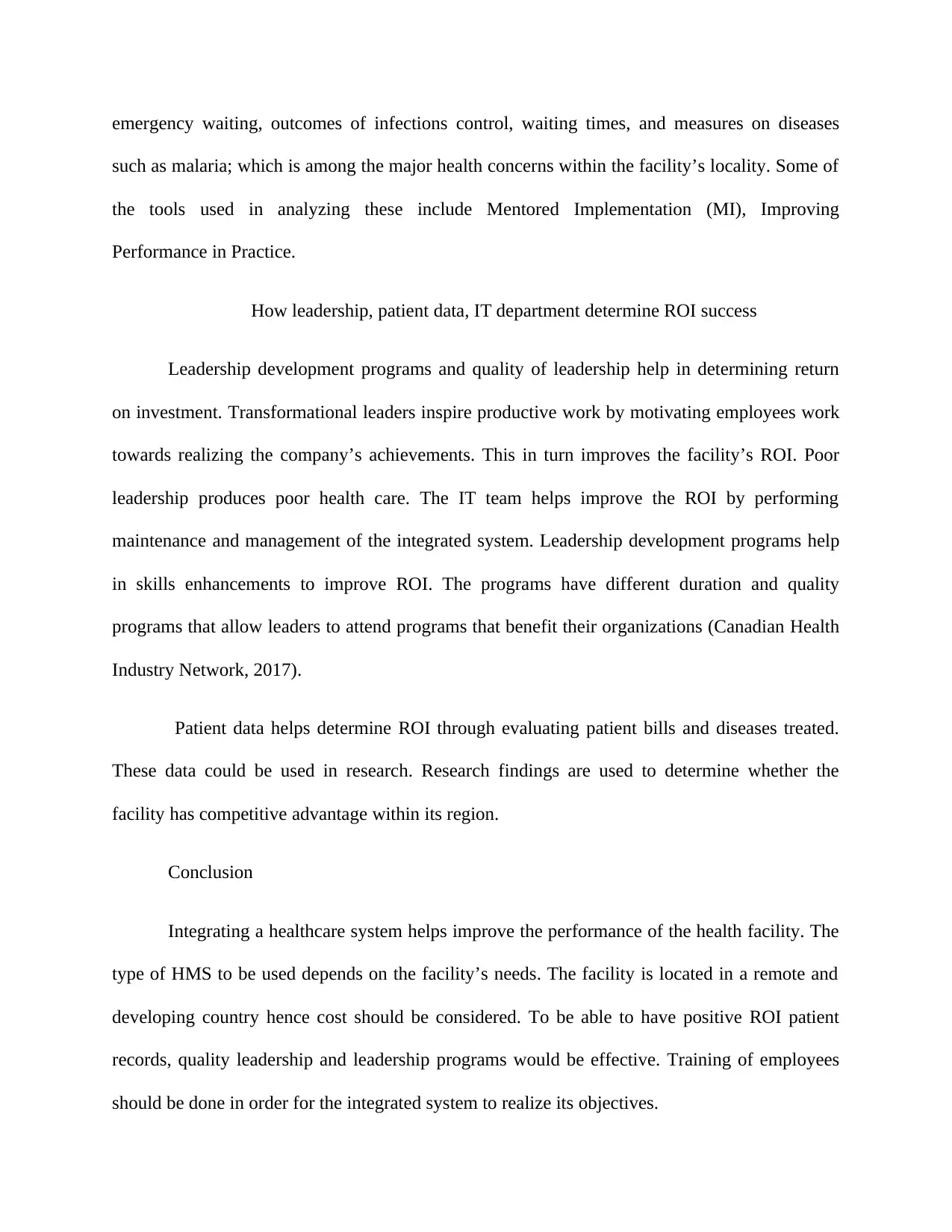
emergency waiting, outcomes of infections control, waiting times, and measures on diseases
such as malaria; which is among the major health concerns within the facility’s locality. Some of
the tools used in analyzing these include Mentored Implementation (MI), Improving
Performance in Practice.
How leadership, patient data, IT department determine ROI success
Leadership development programs and quality of leadership help in determining return
on investment. Transformational leaders inspire productive work by motivating employees work
towards realizing the company’s achievements. This in turn improves the facility’s ROI. Poor
leadership produces poor health care. The IT team helps improve the ROI by performing
maintenance and management of the integrated system. Leadership development programs help
in skills enhancements to improve ROI. The programs have different duration and quality
programs that allow leaders to attend programs that benefit their organizations (Canadian Health
Industry Network, 2017).
Patient data helps determine ROI through evaluating patient bills and diseases treated.
These data could be used in research. Research findings are used to determine whether the
facility has competitive advantage within its region.
Conclusion
Integrating a healthcare system helps improve the performance of the health facility. The
type of HMS to be used depends on the facility’s needs. The facility is located in a remote and
developing country hence cost should be considered. To be able to have positive ROI patient
records, quality leadership and leadership programs would be effective. Training of employees
should be done in order for the integrated system to realize its objectives.
such as malaria; which is among the major health concerns within the facility’s locality. Some of
the tools used in analyzing these include Mentored Implementation (MI), Improving
Performance in Practice.
How leadership, patient data, IT department determine ROI success
Leadership development programs and quality of leadership help in determining return
on investment. Transformational leaders inspire productive work by motivating employees work
towards realizing the company’s achievements. This in turn improves the facility’s ROI. Poor
leadership produces poor health care. The IT team helps improve the ROI by performing
maintenance and management of the integrated system. Leadership development programs help
in skills enhancements to improve ROI. The programs have different duration and quality
programs that allow leaders to attend programs that benefit their organizations (Canadian Health
Industry Network, 2017).
Patient data helps determine ROI through evaluating patient bills and diseases treated.
These data could be used in research. Research findings are used to determine whether the
facility has competitive advantage within its region.
Conclusion
Integrating a healthcare system helps improve the performance of the health facility. The
type of HMS to be used depends on the facility’s needs. The facility is located in a remote and
developing country hence cost should be considered. To be able to have positive ROI patient
records, quality leadership and leadership programs would be effective. Training of employees
should be done in order for the integrated system to realize its objectives.
Paraphrase This Document
Need a fresh take? Get an instant paraphrase of this document with our AI Paraphraser
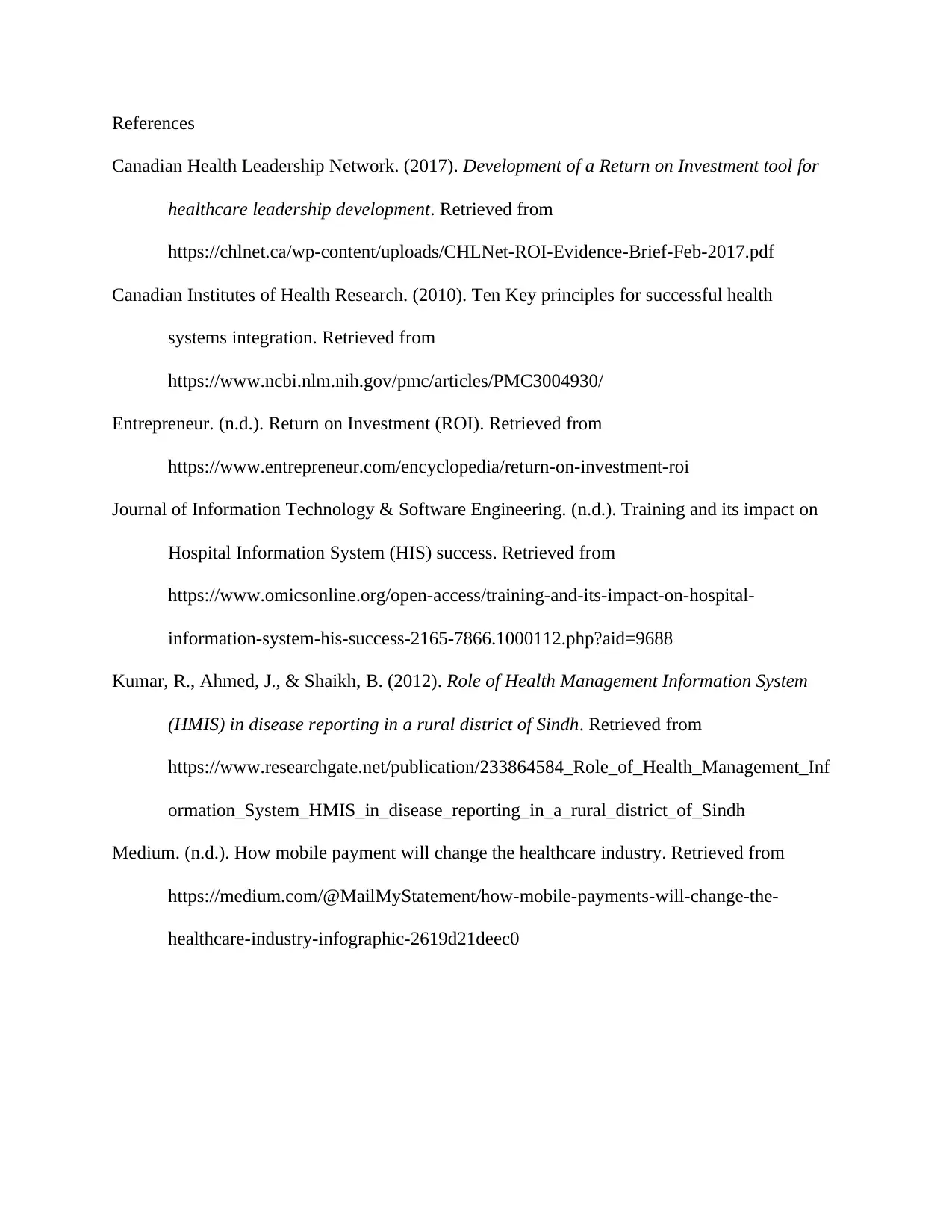
References
Canadian Health Leadership Network. (2017). Development of a Return on Investment tool for
healthcare leadership development. Retrieved from
https://chlnet.ca/wp-content/uploads/CHLNet-ROI-Evidence-Brief-Feb-2017.pdf
Canadian Institutes of Health Research. (2010). Ten Key principles for successful health
systems integration. Retrieved from
https://www.ncbi.nlm.nih.gov/pmc/articles/PMC3004930/
Entrepreneur. (n.d.). Return on Investment (ROI). Retrieved from
https://www.entrepreneur.com/encyclopedia/return-on-investment-roi
Journal of Information Technology & Software Engineering. (n.d.). Training and its impact on
Hospital Information System (HIS) success. Retrieved from
https://www.omicsonline.org/open-access/training-and-its-impact-on-hospital-
information-system-his-success-2165-7866.1000112.php?aid=9688
Kumar, R., Ahmed, J., & Shaikh, B. (2012). Role of Health Management Information System
(HMIS) in disease reporting in a rural district of Sindh. Retrieved from
https://www.researchgate.net/publication/233864584_Role_of_Health_Management_Inf
ormation_System_HMIS_in_disease_reporting_in_a_rural_district_of_Sindh
Medium. (n.d.). How mobile payment will change the healthcare industry. Retrieved from
https://medium.com/@MailMyStatement/how-mobile-payments-will-change-the-
healthcare-industry-infographic-2619d21deec0
Canadian Health Leadership Network. (2017). Development of a Return on Investment tool for
healthcare leadership development. Retrieved from
https://chlnet.ca/wp-content/uploads/CHLNet-ROI-Evidence-Brief-Feb-2017.pdf
Canadian Institutes of Health Research. (2010). Ten Key principles for successful health
systems integration. Retrieved from
https://www.ncbi.nlm.nih.gov/pmc/articles/PMC3004930/
Entrepreneur. (n.d.). Return on Investment (ROI). Retrieved from
https://www.entrepreneur.com/encyclopedia/return-on-investment-roi
Journal of Information Technology & Software Engineering. (n.d.). Training and its impact on
Hospital Information System (HIS) success. Retrieved from
https://www.omicsonline.org/open-access/training-and-its-impact-on-hospital-
information-system-his-success-2165-7866.1000112.php?aid=9688
Kumar, R., Ahmed, J., & Shaikh, B. (2012). Role of Health Management Information System
(HMIS) in disease reporting in a rural district of Sindh. Retrieved from
https://www.researchgate.net/publication/233864584_Role_of_Health_Management_Inf
ormation_System_HMIS_in_disease_reporting_in_a_rural_district_of_Sindh
Medium. (n.d.). How mobile payment will change the healthcare industry. Retrieved from
https://medium.com/@MailMyStatement/how-mobile-payments-will-change-the-
healthcare-industry-infographic-2619d21deec0
1 out of 5
Related Documents
Your All-in-One AI-Powered Toolkit for Academic Success.
+13062052269
info@desklib.com
Available 24*7 on WhatsApp / Email
![[object Object]](/_next/static/media/star-bottom.7253800d.svg)
Unlock your academic potential
Copyright © 2020–2025 A2Z Services. All Rights Reserved. Developed and managed by ZUCOL.





